 |
|

|
 |
TABLE of CONTENTS
 |
Online knowledge-sharing system coming to MnDOT |
By Rich Kemp
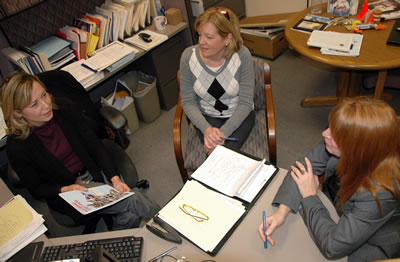
From left, Jeanne Aamodt, Customer Relations manager, and Linda Davis-Johnson, division business manager, talk with Carol Hennekens, Leadership Development Program manager, about the new iConnect knowledge-sharing system. Photo by Rich Kemp |
MnDOT employees can learn from each other using a new program called iConnect, a web-based collaborative learning network that provides employees with the opportunity to share expertise, perspectives, experiences and resources.
“We have been waiting for a mentoring system at MnDOT,” said Linda Draze, system administrator for iConnect. “This system will accomplish that, but it will also allow for knowledge sharing across the organization at all levels.”
Those invited to participate in the Phase 1 of the program are Leadership Development Program participants and Board members; training staff (e.g., employee development specialists); and the 2012-13 cohorts of MnDOT’s Leadership Foundations Program.
The program is intended to ensure a strong workforce for the present and future, and increase the breadth and participation in the Leadership Development Program. The program will encourage collaborative learning across disciplines (e.g., planners and engineers, maintenance/construction and finance).
“Depending how successful it is this year, we will look at expanding the program in the future,” said Draze.
Anyone who creates an account in the system can be both an “advisor” (mentor) and a “learner” (mentee), depending on what they are looking for. Everyone has experience in different areas, so the concept of collaborative learning across the organization is strongly supported through use of this tool, Draze said.
iConnect features include reporting and tools to help measure success.
Information will be sent to those in the participating groups during the week of March 11 with more information on the program and how to get started.
Funded by Destination Innovation dollars, the project is connected to MnDOT’s Workplace of Choice initiative.
For more information about iConnect, contact Draze at linda.draze@state.mn.us or Carol Hennekens at carol.hennekens@state.mn.us.
|
 |
|

|
 |
TABLE of CONTENTS
 |
New device fixes pipes by smashing them |
By Bob Filipczak
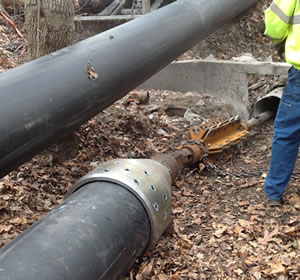
The pipe-bursting head seen here is inserted into the problem pipe, expanding the pipe from the inside while pulling a thick plastic pipe behind it to replace the reinforced concrete pipe. This procedure was first used in a project in the Metro District last summer in Chisago City near Hwy 8. Photo by D.W. Bauer |
“If it ain’t broke, you’re not trying.” – Red Green Show
Fixing concrete on roads presents certain challenges, but the Metro District Water Resources team and Maintenance often face the difficult task of fixing broken concrete pipes far below ground. They have recently used a new device that reduces the time and effort it takes to fix storm sewers—by smashing right through them.
The first time this new pipe-bursting procedure was included in a project in the Metro District was last summer in Chisago City near Hwy 8. The storm sewer pipe that ran to the nearby lake had collapsed, creating a sinkhole in a resident’s back yard.
Normally, that would mean digging up the whole line of pipe and replacing it, while dealing with all the obstacles and associated costs of working in a neighborhood with mature trees and in close proximity to residential homes.
The pipe-bursting head, on the other hand, is inserted into the problem pipe, and expands it from the inside while pulling a thick plastic pipe behind it to replace the reinforced concrete pipe. In this case, the head was about 22 inches in diameter while the pipe it was breaking apart—and forcing the pieces outward into the surrounding dirt—was about 18 inches. The heavy-duty plastic pipe follows the head and seamlessly replaces it.
The pipe-bursting system is driven by either pneumatic pressure or using static connections to push or pull it forward.

This diagram shows how the pipe-bursting technique works. Photo courtesy of U.S. Army Corps of Engineers |
This new system fixed the storm sewer while saving the Metro District Water Resources team many months of work and an immeasurable inconvenience for the residents and the loss of mature trees. In the case of the pipe on Hwy 8, the pipe-bursting system crunched and replaced about 800 feet of storm sewer.
“It works well with reinforced concrete pipe, but not so well with corrugated steel pipes. The head tends to crumple those pipes like an accordion,” said Bryce Fossand, senior engineer with Metro District’s Water Resources team.
He hopes to be able to use this system again in the future. |
 |
|

|
 |
TABLE of CONTENTS
 |
Maintenance efforts to reduce salt use on roads will improve agency’s effect on environment |
|
By Lisa Yang
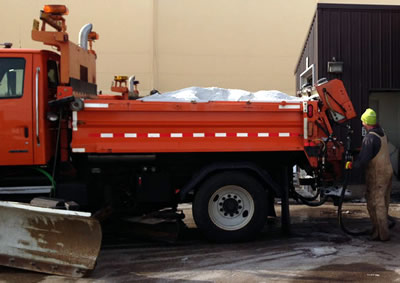
A maintenance employee attaches a brine hose to a plow truck. Brine or wetted salt is usually applied to roads shortly before a snowstorm arrives. Photo by Bob Filipczak |
MnDOT’s efforts to decrease the use of road salt in the last several snow and ice seasons have become a critical piece in improving the health of the environment.
About 75 percent of salt, also known as sodium chloride, found in the Twin Cities Metro area is from salt used to de-ice roads, parking lots and walkways, according to the Minnesota Pollution Control Agency. Chloride is toxic to aquatic life, destroys vegetation, corrodes vehicles, and affects aesthetics and infrastructure. It also contaminates drinking water, which can affect human health.
MnDOT’s average salt usage during the past four seasons is approximately 208,000 tons, according to Steve Lund, state maintenance engineer.
“There needs to be a balance between public safety and environmental effects from sodium chloride,” said Mark Fischbach, Metro District’s clear roadways superintendent. “The challenge is finding that balance.”
Effective snow and ice management and best practices have been put into place to help achieve that balance. Improvements have come with training programs such as MnDOT’s Snow Plow Operator’s Training and the Circuit Training provided by a partnership with the Local Technical Assistance Program that teach plow drivers about salt and when to use other chemicals and materials.
“Salt is temperature-dependent. Below 15 degrees, the effectiveness of salt is greatly reduced. If operators don’t know this, we have a potential for over-application,” said Kathleen Schaefer, LTAP salt solutions trainer and former snow plow operator. “The training focuses on three thing: using the right material, in the right amount, at the right time.”
MnDOT relies on salt because of its effectiveness and cost. However, alternative chemicals, such as magnesium chloride, are added to salt to enhance its performance at lower temperatures.
“This saves on unnecessary use of salt when it really isn’t as effective as we need it to be,” said Lund.
Three main techniques—anti-icing, pre-wetting and de-icing—are used statewide.
- Anti-icing is primarily a liquid chemical application process where a chemical is applied to the road surface before a frost or snowfall, helping prevent ice and melted snow from forming a bond with the road surface.
- Pre-wetting is the addition of a liquid chemical or brine to salt or sand just prior to use. By wetting the material before applying it to roads, the mixture adheres to the road instead of blowing off to the shoulder. It also melts snow and ice quicker by jumpstarting the melting process.
- De-icing includes using chemical salt or mechanical means such as plow blades to break the bond that has formed between the ice and the pavement.
About 80 percent of MnDOT trucks in the Twin Cities area are outfitted with on-board pre-wetting, which means plow operators can create a pre-wetting mixture without returning to their shops when temperatures and conditions change. The other trucks will be outfitted through scheduled attrition.
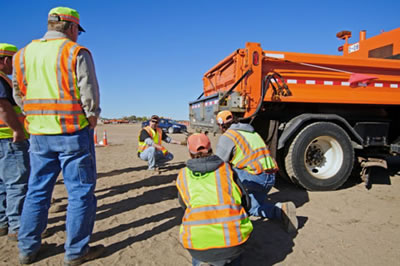
MnDOT plow operators statewide attend the Snow Plow Operators Training in Camp Ripley on an annual basis to learn or get refreshed on equipment, materials and techniques. Photo by David Gonzalez |
Operators need to feel confident that their equipment is delivering the amount of salt that they’re calling for, so MnDOT and LTAP provide hands-on calibration training for both electronic and manual controllers.
Metro District has a slurry system which can be installed onto trucks. The system provides a super-saturated salt application which is a higher liquid to granular ratio that is roughly 20 gallons of brine per ton of salt. This further reduces the overall salt usage.
MnDOT also uses a salt and liquid mixing blender to incorporate liquid de-icing product onto rock salt for stock pile storage. The addition of the liquid de-icing product assists in the efficiency of the melting process when that salt is applied to the roadway.
Throughout the state, certain bridges have built-in or retrofit anti-icing systems installed that automatically trigger chemical application when sensors indicate that there’s a need. These systems often use a non-chloride product called potassium acetate that is effective in very cold temperatures.
MnDOT pioneered the use of living snow fences which are barriers made of trees, shrubs and native grasses located along roads in communities and farmsteads. Living snow fences trap snow as it blows across fields, piling it up in ditches before it reaches a road. This reduces plow time and salt use while keeping roadways clear for motorists.
MnDOT is partnering with MPCA, watershed organizations, cities and counties to help develop implementation strategies in the next two years that will decrease the amount of chloride being used at the local level.
A Maintenance Operations Research Program and a New Technology and Research Equipment Committee provide new technology to the districts, encourage the development of ideas and methods by employees and implement research projects that improve transportation, save money and often help to protect the environment.
But, as Lund says, “We get our biggest return on efforts to protect the environment from the training we give to our snow fighters.”
“We want to be stewards of the environment. We want to be part of the solution and not part of the problem,” said Fischbach. “Moving forward with these best practices and various tools and techniques will ensure we reduce our contribution to chloride levels in the environment and that we begin moving towards more sustainable operations.”
For more information on MnDOT’s efforts to reduce salt use, visit www.mndot.gov/maintenance/research/research.html. |
 |
|

|
 |
TABLE of CONTENTS
 |
Bruce Lattu, disability programs coordinator, dies at 60 |

Bruce Lattu, long-time advocate for people with disabilities, died March 4. Photo by David Gonzalez |
Bruce Lattu, disability programs coordinator in the Office of Affirmative Action, died March 4 after a lengthy illness. He had been on medical leave from work since August.
Lattu, 60, was a 27-year state employee who was known as “a champion for people with any kind of disability,” said Lynnette Geschwind, Office of Affirmative Action director. “Bruce was an outstanding member of our team and did a tremendous amount of work, from designing and delivering training to coaching supervisors to serving on the statewide affirmative action committee. He had a keen intellect and a generous spirit.”
Lattu received the Minnesota Award from the Minnesota State Council on Disability in December. The award is MSCOD’s highest honor to a Minnesotan with a disability who has worked to enhance the empowerment and employment of individuals with disabilities.
In 2001, Lattu received a kidney transplant. After developing severe complications from a staph infection, his lower right leg had to be amputated. Lattu became a beneficiary of the state’s vacation donation program, and later, an advocate for it.
“Whether it’s for someone you know or for a complete stranger, your vacation hours will support a worthy program, for a worthy cause, for a worthy person. I feel blessed to have had so many people care enough to help me out, and I know the person (or people) you help will feel that way, too,” he wrote in 2006 for MnDOT Newsline.
“Despite his physical hardships, he was a completely optimistic, compassionate person,” said DeLorah Curry, Office of Human Resources, who partnered with Lattu to teach MnDOT’s Respectful Workplace training. “He was charismatic and funny. Bruce enjoyed the work and enjoyed the people.”
Geschwind added, “MnDOT reports more reasonable accommodations than any other state agency because of Bruce’s work. He was all about treating people with respect.”
Lattu is survived by his wife, Kathy; sons, Antonio and Jose; five grandchildren; two brothers and one sister; as well as many nieces, nephews, friends and co-workers.
Funeral services will be held Thursday, March 7, at 2 p.m. at the Emmanuel Christian Center in Spring Lake Park. Visitation is one hour prior to the service at the church. |
 |
|

|
 |
TABLE of CONTENTS
 |
What’s new on the web? |
By Becky Dahlberg
Mail Center
Need to mail something? Visit the updated mail center site on iHUB for interoffice and external mail delivery and tracking; folding, stuffing and labeling help; proper address placement; cost-saving tips and more. You can find these and other services at ihub/mailcenter/.
MnPASS Express Lanes
The MnPASS website recently got a facelift. It serves two audiences – existing customers and new customers – and now caters to both with a simplified, user-friendly design; while at the same time showcasing how the express lanes work and why they’re needed. Check it out at www.mnpass.org/.
MnSTEP
Now you can find stretch exercise guides for MnSTEP, the department’s new stretching program to reduce workplace injuries, on iHUB! View or print them here: ihub/mnsafe/mnstep.html.
Research services
The research services website has been overhauled and is now in the department’s new mobile friendly web templates. The page layouts have a much cleaner look and feel, emphasizing news items and recent publications, and there is a new calendar of events page for at-a-glance viewing. Browse research reports and subscribe to the research services email list on the new site here: www.dot.state.mn.us/research/.
New regional Twitter feeds
Get local road information throughout the state by checking out the following new Twitter feeds:
- Southeast Minnesota, including Rochester and Winona, at https://twitter.com/mndotsoutheast/ or @mndotsoutheast
- South central Minnesota, including Mankato and Windom, at https://twitter.com/mndotscentral/ or @mndotscentral
- Southwest Minnesota, including Willmar, Hutchinson and Marshall, at https://twitter.com/mndotsouthwest/ or @mndotsouthwest
- West central Minnesota, including Detroit Lakes, Morris and Moorhead, at https://twitter.com/mndotwcentral/ or @mndotwcentral
|
 |
|

|
 |
TABLE of CONTENTS
 |
MnDOT’s STEM program attracts students to engineering field |
By Rich Kemp
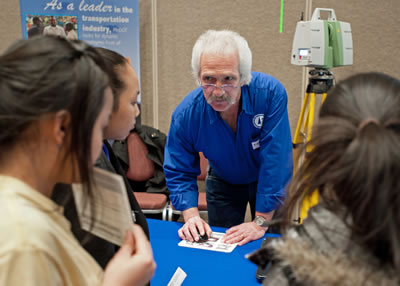
Gary Troge, engineering specialist, demonstrates laser technology for surveying to students Feb. 12 during the STEM expo at the Minneapolis Convention Center. MnDOT Recruitment staff assisted in planning event for the Science, Technology, Engineering and Math program. Photo by David Gonzalez |
MnDOT is reaching out to engage students in engineering degrees through the Science, Technology, Engineering and Math program.
MnDOT, which has been involved in the STEM program since 2006, partners with Project Lead the Way to help get students interested in engineering. MnDOT’s Recruitment Unit in the Office of Human Resources works to find and develop strong candidates at high school and colleges around Minnesota for internships and student worker positions within the agency.
The Phoenix Program, for example, provides paid internships for high school students enrolled in pre-engineering courses at area PLTW high schools. By interning at various MnDOT offices and districts statewide, Phoenix Program students gain on-the-job work experience in a variety of areas such as highway design, traffic, surveying, materials and data analysis.
“The idea of the program is the outreach to get the younger generation interested in engineering,” said Sandy Caron, Recruitment Programs manager.
Recruiting staff members also assist with the STEM program by participating on advisory committees with PLTW and school districts to influence school curriculums and plan activities to keep students interested in STEM.
“The goal is to promote MnDOT and get early recruitment going, so students know at an early age that engineering is a beneficial and interesting career field,” said Calahena Merrick, Phoenix Program manager.
The advisory committees have planned several events to promote STEM. The students participate in activities in the schools and out of the schools. They have done job shadowing, toured 3M, attended career fairs and listened to speakers. In February the advisory committee organized the STEM expo at the Minneapolis Convention Center. MnDOT engineers demonstrated laser technology for surveying and mapping at the expo.
Recently, MnDOT participated in the Science Fusion event at the Science Museum of Minnesota in St. Paul. The four-part series brought scientific and educational professionals together with kids, teens and adults for creative science activities to promote STEM career opportunities.
“The goal of the Recruitment office is to get them early and follow the concept of growing our own,” said Merrick. “The students become part of our program and don’t want to leave.”
For information about MnDOT's Phoenix Program, see www.dot.state.mn.us/jobs/phoenix.html. |
 |
|

|
 |
TABLE of CONTENTS
 |
Public thanks snow crews via social media |
When it comes to Minnesota roads, everyone has an opinion—especially during a snowstorm such as the one that bullied its way through the state March 4-5, dumping 6 to 10 inches of snow across the land.
As usual, MnDOT’s maintenance crews were out in full force, plowing, sanding and de-icing the highways back to good driving conditions. And their efforts did not go unnoticed by the social-media-users of our driving public.
Some of the tweets (and re-tweets) our crews received March 5 include:
- I would like to collectively thank MNDOT and Mother Nature for the snow removal. The roads are fabulously clear!
- Thank you MNDOT!
- Major kudos to the folks at #mndot. The amount of snow moved off the roads over the past 12 hours was impressive. Great work.
- Completely agree with you about #mndot. The amount of snow moved off the roads over the past 12 hours was impressive.
- U folks work hard. Thx for the safe roads today. 100+ miles in the car throughout TC & all good.
- Today I’m incredibly thankful for amazing snow tires & @MNDOT, who has the roads plowed a few hrs after a 10 inch snowfall! #kudos #winter
- Shout out to @mndottraffic @mndotnews MnDOT. Great job on the roads for the evening commute.
And a few of our Facebook followers had these comments to share:
- Go MNDOT! You guys are doing a great job plowing the highways and streets in a timely manner! My Street is already done!! Keep up the good work!
- Thanks to all the dedicated plow drivers for a great job!
- Thanks for clearing the roads so quickly. My commute home was smooth sailing!
Check out MnDOT’s social media sites for other comments and information:
|
 |
|
| |
|



